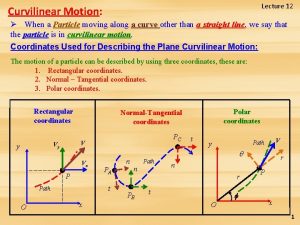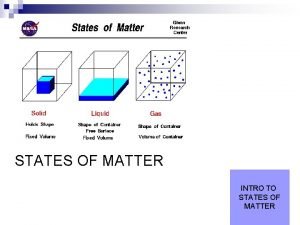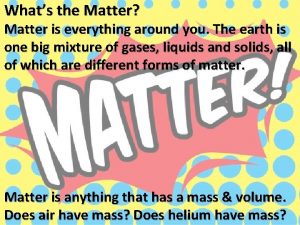Matter in Motion The matter around you is












- Slides: 12

Matter in Motion The matter around you is made of tiny particles—atoms and molecules. • In all materials these particles are in constant, random motion; moving in all directions at different speeds. The faster they move, the more kinetic energy they have. • The particles that make up hot objects move faster than the particles that make up cooler objects. Copyright © Mc. Graw-Hill Education Temperature, Thermal Energy, and Heat

Temperature The temperature of an object is a measure of the average kinetic energy of the particles that make up that object. • As the temperature of an object increases, the average speed of the particles in that object increases. • In SI units, temperature is measured in kelvins (K). • A more commonly used temperature scale is the Celsius scale. • One kelvin is the same as one degree Celsius. Copyright © Mc. Graw-Hill Education Temperature, Thermal Energy, and Heat

Thermal Energy If you let cold butter sit at room temperature for a while, it warms and becomes softer. • Because the air in the room is at a higher temperature than the butter, particles that compose air have more kinetic energy than the particles that compose butter. • Collisions between the particles that compose butter and the particles that compose air transfer energy from the faster-moving air particles to the slowermoving butter particles. • The particles that compose butter then move faster and the temperature of the butter increases. Copyright © Mc. Graw-Hill Education Temperature, Thermal Energy, and Heat

Thermal Energy The sum of the kinetic energy and potential energy of all the particles that compose an object is thermal energy of that object. • Because the kinetic energy of the butter particles increased as the butter warmed, thermal energy of the butter increased. Copyright © Mc. Graw-Hill Education Temperature, Thermal Energy, and Heat

Thermal Energy and Temperature • • When the temperature of an object increases, the average kinetic energy of the particles that compose the object increases. Because thermal energy is the total kinetic and potential energy of all the particles that compose an object, thermal energy of the object increases when the average kinetic energy of its particles increases. Copyright © Mc. Graw-Hill Education Temperature, Thermal Energy, and Heat

Heat is thermal energy that is transferred from something at a higher temperature to something at a lower temperature. • Heat is a transfer of energy, so it is measured in joules—the same units that energy is measured in. Copyright © Mc. Graw-Hill Education Temperature, Thermal Energy, and Heat

Specific Heat The amount of heat that is needed to raise the temperature of 1 kg of a substance by 1°C is called the specific heat of the substance. • As a substance absorbs thermal energy, its temperature change depends on the nature of the substance, as well as the amount of thermal energy that is added. Copyright © Mc. Graw-Hill Education Temperature, Thermal Energy, and Heat

Specific Heat Because water can absorb thermal energy without a large change in temperature, it is useful as a coolant. • A coolant is a substance that is used to absorb thermal energy. • Compared with the other common materials in the table, water has the highest specific heat. • The specific heat of water is high because water molecules are strongly attracted to each other. Copyright © Mc. Graw-Hill Education Temperature, Thermal Energy, and Heat

Water Has High Specific Heat When thermal energy is added, some of the added thermal energy has to break some of the attractions between the water molecules before they can move faster. Copyright © Mc. Graw-Hill Education Temperature, Thermal Energy, and Heat

Metals Have Low Specific Heat In metals, electrons can move freely. When thermal energy is added, no strong attractions have to be broken before the electrons can start moving faster. Copyright © Mc. Graw-Hill Education Temperature, Thermal Energy, and Heat

Changes in Thermal Energy The thermal energy of an object changes when thermal energy is transferred into or out of the object. • If Q is the change in thermal energy and C is specific heat, the change in thermal energy can be calculated from the following equation: Copyright © Mc. Graw-Hill Education Temperature, Thermal Energy, and Heat

SOLVE FOR THERMAL ENERGY Use with Example Problem 1. SOLVE FOR THE UNKNOWN Problem • A wooden block has a mass of 20. 0 kg and a specific heat of 1, 700 J/(kg · °C). Find the change in thermal energy of the block as it warms from 15. 0°C to 25. 0°C. Response ANALYZE THE PROBLEM Set Up the Problem Q = m(Tf – Ti)C • Solve the Problem Q = (20. 0 kg)(25. 0°C – 15. 0°C)(1, 700 J/(kg ·°C)) = (20. 0 kg)(10. 0°C)(1, 700 J/(kg ·°C)) = 340, 000 J KNOWN EVALUATE THE ANSWER mass: m = 20. 0 kg Do the units match on both sides of the equation? Changes in thermal energy (Q) are measured in units of joules (J). On the right side, (units of mass)(units of temperature change)(units of specific heat) = kg × °C × J/(kg ·°C) = J. The units on both sides of the equation match. final temperature: Tf = 25. 0°C initial temperature: Ti = 15. 0°C specific heat: C = 1, 700 J/(kg · °C) UNKNOWN change in thermal energy: Q Copyright © Mc. Graw-Hill Education Temperature, Thermal Energy, and Heat
 What goes around comes around examples
What goes around comes around examples Goes around comes around meaning
Goes around comes around meaning Everything around us is made of
Everything around us is made of Passive rom vs active rom
Passive rom vs active rom Harmonic motion equation
Harmonic motion equation An object in motion stays in motion
An object in motion stays in motion Chapter 2 motion section 1 describing motion answer key
Chapter 2 motion section 1 describing motion answer key What is acceleration
What is acceleration Section 1 describing motion worksheet answer key
Section 1 describing motion worksheet answer key Concept 1 notes describing motion
Concept 1 notes describing motion Motion section 1 describing motion
Motion section 1 describing motion Curvilinear motion matter
Curvilinear motion matter Intro to matter
Intro to matter























